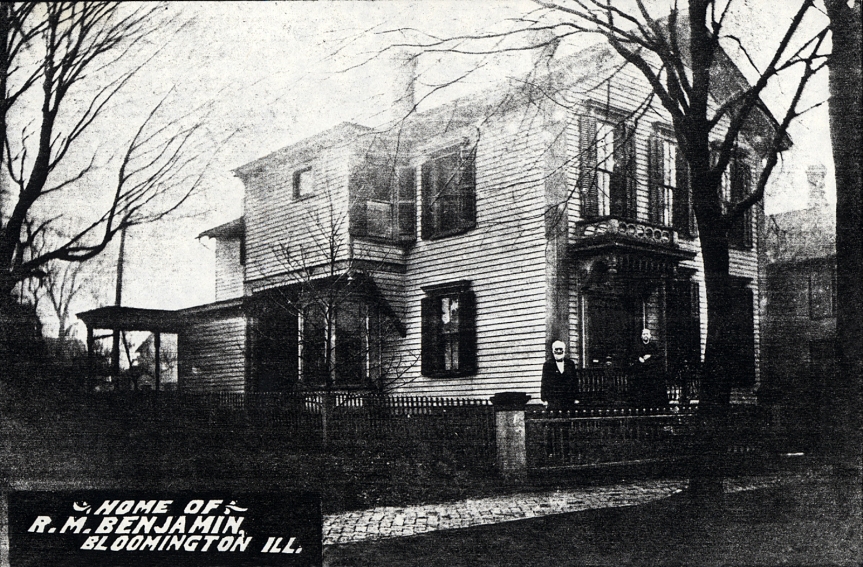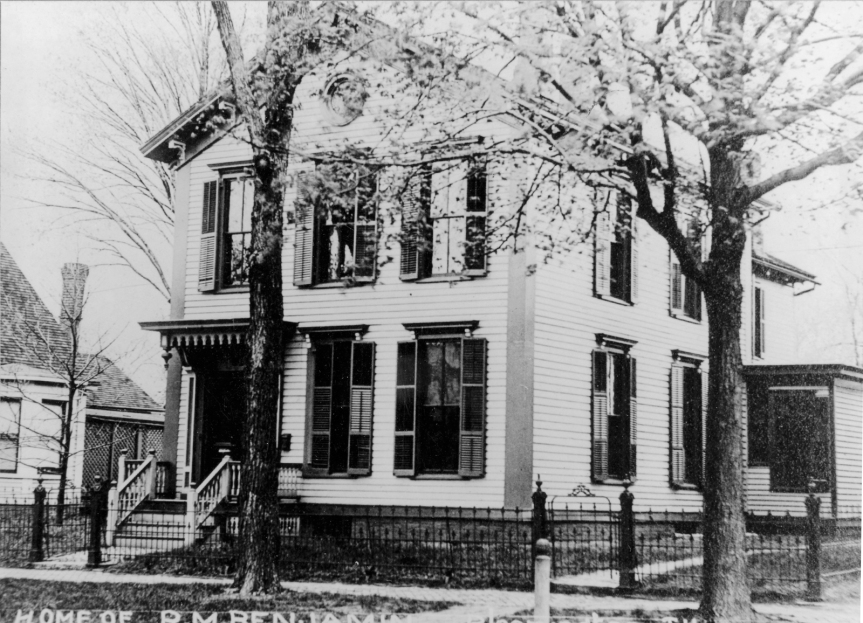
Welcome to the history of The Rueben M. Benjamin House at 510 E. Grove St. Bloomington, Illinois
By Ken and Carol Kashian
Let me begin by acknowledging the inconsistencies found when doing historical research. We have found such to be the case in accurately dating our property; one source has it being built in 1853, another in 1854, and yet another in 1856. 1853 is the date most often given and the date cited for designation on the National Register of Historic Places in 1978.
A second inconsistency found is in the spelling of Ruben or Rueben? Technical references suggest the spelling of RUBEN but archives continue to show RUEBEN.
In our own research, we believe the date of September 15, 1853 to be when John L. Routt purchased the property for $400 and began construction, which was completed in 1854.
Benjamin purchased home in 1856 for $1875 and the Benjamin family through 1936 owned the house.
One of the first occupants living here was William Wallace, one of the founders of IWU and Second Presbyterian Church. According to dates found, he only lived here a year (January 19, 1855 until his death in February 1856).
John L. Routt (1826-1907) was a 19-year-old carpenter when he built this house. He fought in the Civil War and earned particular distinction at the Battle of Vicksburg. He gained the respect and friendship of General Ulysses Grant who appointed him governor of Colorado, whereby he holds the distinction as the last appointed governor and the first elected governor of Colorado in 1876. Routt’s duties as governor lost in priority to mining. He owned his first mine in Leadville, CO and expanded this ownership to ten mines by the late 1800’s. He is often portrayed as the governor that, more frequently than some legislators preferred, labored with pick and shovel along side the workers in his mines. Routt and his partner sold the mines, of which his reported share was in excess of $600,000. The state of Colorado recognizes his contribution with the designation of Routt County (which includes Steamboat Springs) and a commemorative stained glass window is prominently displayed in the Senate chambers of the Colorado State Capital Building.
Rueben Moore Benjamin was born June 29, 1833 on a farm near Chatham Center, Columbia County, New York. His father was a soldier in the War of 1812 and his grandfather, Ebeneezer Benjamin, a captain in the Revolutionary army. He graduated from Amherst in 1853 with honors. and attended Harvard Law School.
He arrived to Bloomington April 24, 1856 and on the next week entered the law office of General Asahel Gridley and Colonel H. H. Wickizer. On September 5, 1856 he went to Lincoln, IL where he appeared before Judge David Davis for his bar examination—one of the three examiners was Abraham Lincoln. He passed and Lincoln signed his certificate.
He then returned to Chatham NY and married Laura Woodin September 15, 1856. They returned to Bloomington and set up house on October 10, 1856.

Rueben immediately entered into partnership with Gridley and Wickizer and remained until 1863 when he formed a partnership with Thomas F. Tipton. Over the course of his active law career, he practiced additionally with Captain J.H. Rowell and Lawrence Weldon, and lastly with John J. Morrisey. He served in the union Army in Tennessee for several months during the Civil War. In 1869 he was elected to the constitutional convention to redraft the Illinois Constitution of 1870. In 1873 he was elected without opposition to county judge. He was reelected in 1877 and in 1882 retired voluntarily without being a candidate. He was made Dean of the law school at IWU upon its organization in 1874 and also was an instructor in constitutional law. He retired in 1893 from the practice of law and focused on writing and teaching.
Benjamin was known as a populist lawyer fighting for regulation of monopolies and trusts. He took the Chicago and Alton Railroad to court for unfair fees for hauling lumber. The success of this legal activity led to the development of the Interstate Commerce Commission. Although a radical, he strictly adhered to the Republican’s Party ideals. He was described as a “pioneer anti-monopolist” and at the same time a “radical opponent” of socialism.
The house is an example of the popular English Side-Hall design developed on the east coast and adopted as a means of the economical use of space when building on a narrow urban lot. It has Greek Revival details such as pilasters, tall windows, and a pediment roof. The rounded attic window and the roof brackets reflect Italianate influences. It was the first house built on the north side of Grove Street. In 1978 The Rueben M. Benjamin house became one of the first of McLean County properties to be listed on the National Register of Historic Places.
In 1992, the Old House Society designated the property as a “Gift to the Street”.
![0 R UMAX Power Look 2000 V1.8 [3]](https://dimmittsgrove.files.wordpress.com/2019/03/sideporch.jpg?w=863)
The property remained in the Benjamin family upon the death of Sarah. Several other owners occupied and at one time, it was converted into a duplex with a side entrance on the driveway (east) side—which has been since removed. The most significant rehabilitation is credited to Jim and Lucy Koehler, who acquired it in 1978, returning it to the Benjamin floor plans and obtaining National Historic Certification. Jeannie and Bruce Breitweiser purchased the property in 1987 and were responsible for greek revival period wall paper in the entry and parlor, returning of the floors in the original sections of the house to unfinished pine, color selection for outside of house and building garage. We purchased the property in June 1997.
Significant items to point out are “keyhole” door frames, “inverted cross” four panel doors. The family room\kitchen are original spaces but not original configuration.
Brief background history of Grove Street and early Bloomington
The Bloomington area was at edge of a large grove occupied by the Kickapoo people before the first Euro-American settlers arrived in the early 1820’s. Originally called Blooming Grove, Bloomington was named as county seat on December 25, 1830 when McLean County was created.
Until arrival of railroads in 1853 the town grew slowly and relied solely on locally produced lumber and bricks. A lone survivor of that pre-railroad era is the Miller-Davis Law Building on the corner of Main and Front—now Rosie’s Pub.
The area around Grove Street in the 1830’s was mostly still farmland—William Dimmitt and William Evans owning large amounts of property. He sold much of his property into “town lots” for the area was desirable due to its proximity to both downtown and railroads.
Story has it the both Dimmitt and Evans proposed to the city a joint deed and street formation. When Dimmitt learned that the street was to be named Evans Street, he took back his half of the deed and thus, Evans Street is the narrowest one in Bloomington.
The East Grove Street Historic District includes 400-700 and nomination was approved in 1987. The street was once the northern boundary of the Blooming Grove from which the name of both the street and city of Bloomington were derived.Most of the houses were built during the mid-19th to early 20th century and the street still retains a strong visual association with that time period.
Today Clinton, Washington, Gridley and Oakland border the Dimmitt’s Neighborhood. We have an active association, which was initiated in 1987. We have both single homes and multi-living units. Population is very diverse with young families, singles, retirees, white collar, blue collar, etc. A neighborhood park was initiated and constructed by neighbors and city in the late 80’s.

The association has sponsored several “Historic Day in Dimmitt’s Grove” to share history and area to visitors. These have included house, garden and walking tours, musical entertainment and food. Sidewalk grants have been given to assist homeowners replacing deteriorated and unsafe sidewalks.


